ISSN ONLINE(2320-9801) PRINT (2320-9798)
ISSN ONLINE(2320-9801) PRINT (2320-9798)
Rahul S. Rode1 , Nikhil A. Dahelkar2, Nikhil R. Nagdive3, Anagha S. Gajbhiye 4, Prof. Manish K. Shriwas5
|
| Related article at Pubmed, Scholar Google |
Visit for more related articles at International Journal of Innovative Research in Computer and Communication Engineering
Authentication is a significant issue in system control in computer based communication. Human face recognization is a important biometric verification and has widely used in many applications such as video monitoring system, human computer interaction, door control system and network security. The automatic face recognization system was designed with the aim that to mark attendance of student in classroom automatically. This system continuously captures images of classroom and by comparing this image with database images system will mark attendance of present students automatically and provide list of absent students. This system will reduce human efforts and also time required to take attendance and also will increase accuracy.
KEYWORDS |
| Skin classification, noise removal, gray scale, histogram normalizations, image acquisitions |
I. INTRODUCTION |
| The human Face is very important in doing interactions with people and conveying people’s identity. Facial recognition offers several advantages. Face recognition technology is gradually evolving to universal Biometric solution, since it requires virtually zero efforts from the user end while compared with other biometric options[2]. As compared with other biometrics systems such as retina scanning, finger print or palm print scan face recognization has lots of advantages because in it non contact process is used. In face recognization technique the image is captured from distance and the identification does not required actual interaction with a person. Traditionally, student’s attendances are taken manually by using attendance sheet given by the faculty members in class. |
| This method of registering attendance can be easy and easily manipulated. Moreover, this methods are tedious and time consuming also it is very difficult to verify one by one student in large classroom environment with distributed branches whether the authenticated students are actually responding or not. In many of the reputed universities the video streaming service of lecture achieve is readily available in system .If the attendance of the students of classroom lecture is attached to the video streaming services. It is possible to present the video time when he or she was absent. The system also provides for continuous monitoring of classroom by an operator if needed. Continuous observation improves the performance for estimation of attendance [6]. |
| In face-recognization technique, identification can be done from two feet away or more without any wait by the user for long period of time just looking towards camera is required. It is possible to estimate automatically whether each student present or absent. It is also possible to know whether students are awake or sleeping and whether students are interested or bored in lecture. If face image are annotated with student’s name, time and place. In addition face recognition technique also used for the crime deterrent purpose, because captured face images that recorded and later identify a person[8]. Public safety authorities want to locate certain individuals like criminals, suspected terrorists, and missing children. The Facial recognition system is useful for the public safety authorities in their mission. Some more applications of face recognization are face recognition is also useful in human computer interaction, virtual reality, database recovery, multimedia, computer entertainment, information security e.g. operating system, medical records, online banking., Biometric e.g. Personal Identification - Passports, driver licenses, Automated identity verification - border controls, Law enforcement e.g. video surveillances , investigation, Personal Security - driver monitoring system, home video surveillance system. There are many different methods to perform face recognization technique. The method the simplest method for face recognization is by Image processing technique. In this paper we will summarized the Automatic attendance system by face recognization using Image processing technique. |
II. SYSTEM ALGORITHM |
| This section describes the software algorithm for the system. |
| The algorithm consists of the following steps: |
| 1. Image acquisition |
| 2. Gray Scale |
| 3. Histogram normalization |
| 4. Noise removal |
| 5. Face detection |
| 6. Face recognition |
| 7. Attendance |
| In the first step image is captured from the camera. There are illumination effects in the captured image because of different lighting conditions and some noise which is to be removed before going to the next steps. Histogram normalization is used for contrast enhancement in the spatial domain. Median filter is used for removal of noise in the image. There are other techniques like low pass filter for noise removal and smoothing of the images but median filter gives good results. These are given below: |
A. Image Aquisation |
| In Biometric face recognization image capturing is the very first step. For that purpose electro optical camera is the only hardware required. As to capture image there is no need to do any physical contact with the hardware i.e. camera so that it is very advantageous method. This method can be accomplished by scanning already captured image or by taking live picture by electro- optical camera. But, for automatic attendance we must take live image captured by camera. The rate of recognization decreases when face images are of various pose and pose angle above 30 degree. But this drawback can be eliminated by capturing multiple and updated images of the object. This captured image is shown in fig.1. The shown in fig.1 is the sample image, in which we will apply the face reorganization technique. It is image which is simply captured by the camera. |
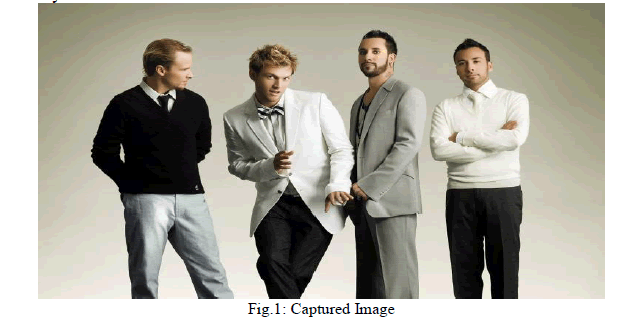 |
B. Gray Scale |
| The every picture captured by the camera is firstly in RGB mode. Image captured sometimes have brightness or darkness in it which should be removed for good results. The enhanced gray image is as shown below: |
| The camera RGB representation of color image is not perfect for characterizing skin color. In RGB component along with color, luminance is also considered. Luminance varies with the person’s face due to lighting and it is not reliable in representing skin from non skin region. In RGB mode comes with the difficulties like complexity of code, difficulty of visualization and effect of Speed s. These drawbacks of RGB mode is overcome by using the gray mode system. The code for image processing in gray form is simple than that of RGB image. The visualization of gray image is simple and also processing speed of gray image is improved than that of RGB image. Grayscale is range of darkness of shades of gray without apparent colour. In case of transmitted light i.e. image on computer display, the brightness levels of RGB component are each represented in decimal from 0 to 255 and in binary from 00000000 to 11111111. For every pixel in a RGB grayscale image, R=G=B. In gray image black colour is represented by R=G=B=00000000 and white colour is represented by R=G=B=11111111. This imaging technique is called 8 bit gray scale. The gray scale image is shown in fig.2. In which the captured image is converted into gray scale image which contain better illumination effect than RGB image. |
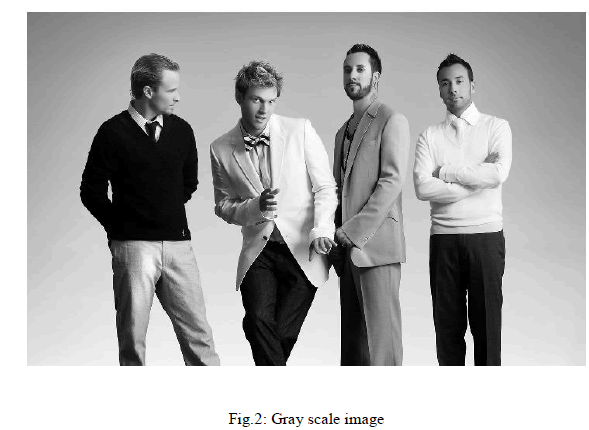 |
C. Histogram Normalization |
| Histogram equalization is a technique in image processing of contrast adjustment using Image’s Histogram. By using this method the global contrast of many images gets increased, especially when the useful information of image’s is represented in close contrast values. Due to this the intensities can be better spread on the histogram. This gives for the area of lower local contrast to gain high contrast. This technique is useful in images of bright or dark backgrounds and foregrounds. The method is used in X-ray images better view of bone structure and to get better details in images that are over or under exposed. The main advantage of this technique is that, it is straight forward technique and invertible operator. Disadvantages of this method are that it is not marked by fine distinction. While decreasing usable signal it may increase the contrast of background noise. It is produces unrealistic effects in photographs. Histogram equalization is useful in scientific images like thermal, X-ray or satellite images. Histogram equalization work best when applied to images with much color depth than palette size, like continuous information or 16-bit gray scale image. The histogram normalize image is shown in fig.3.in which the gray scale image data is get represented in close contrast values. |
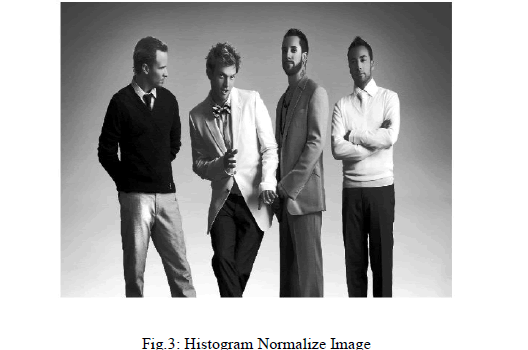 |
D. Noise Removal |
| During image processing noise may introduce into an image document that will affect performance of face recognization algorithm. Noise filter algorithm is used for removing noise so that performance of face reorganization will be improved. Through the facial expression human express their emotions. Antonio. R.C. Paiva has suggest that when we talk about network noise is added as unwanted variation in the image when image is transmitted over the network, it causes wrong conclusion in the recognization of the image in authentication and also in pattern recognization process. For that we are using median filter method show in figure 4. In that primarily there should be removable of noise from image of features are detected. Noise in the imaging system is either additive or multiplicative [15]. There are various noise are present in image they are classified into Gaussian noise, or amplifier noise, implosive noise, or salt and pepper noise ,quantization noise, film grain noise, shot noise and nonisotropic noise. However in our algorithm we have considered impulsive noise, salt and pepper noise. Median filter is non linear process. It is useful in minimizing impulsive or salt and pepper noise. It is also helpful in preserving edges in an image while reducing noise. In communication channel impulsive or salt and pepper noise occure due to a random bit error. In a median filter the intensity value of pixel with in window and window slide along image become output intensity of pixel being processed. In fig.4 the noise in the image is get removed by using the median filter method by using that the performance of face reorganization will be improved. |
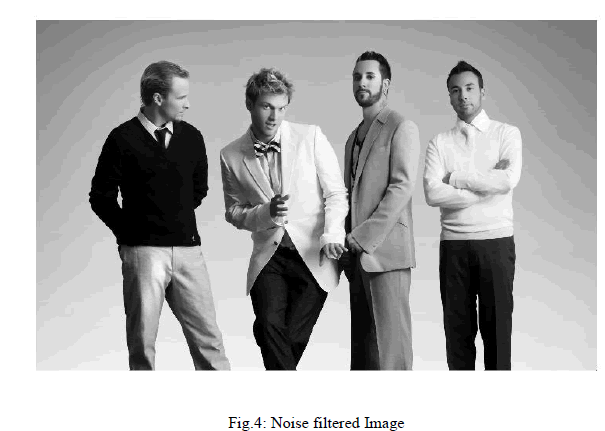 |
E. Face Detection and Crop Image |
| It is computer technology that identifies human faces in digital images. Face detection detects human faces which are used for recognizing particular face. Now a day this technology is being used in variety of applications. It is also refer as physiological process by which human locate and attained two faces in visual image. Face detection is a specific case of object class detection. In object class detection the task is to find the size of all objects in the image and their location that belongs to a given class ex. Includes vans, cars. In face detection algorithm we focus on detection of frontal human faces. It is analogues to image detection and the image of person is matched bit by bit. Tim Rawlinson, Abhir Bhalerao suggest that the image store in database is matched with the real image if there is any facial features change in the database will invalidate the matching process. The range of visual properties such as color and orientation will affect the ability to detect the faces [12]. Face detection is used in biometrics as a part of facial recognization system. It is also useful in image database management human computer interface etc. it has many applications such as photography, marketing. |
 |
| These images will store into the database with the person’s name, unique ID, contact details etc. The cropped images are shown in fig.5. For facial recognization we have to again take image of whole classroom after that all the image processing steps should be applied on this image |
III. FACIAL RECOGNIZATION |
| A facial recognition system is one of the computer applications for automatically identifying person from digital image or a snapshot from video source. In that technique the image and a facial database is compared with selected facial features from the image. Sujata G. Bhele, V.H.Mankar suggests that it is used in various systems like security systems and can be compared to other biometrics like eye iris recognition or fingerprint system [1]. Tetsuo SHOJI, Koh KAKUSHO suggest there are different techniques of facial recognition like traditional, 3D recognition and skin texture analysis [5]. |
A. Traditional |
| Some facial recognition algorithm detects facial features by extracting landmarks from an image of the subject. An algorithm may recognize the relative position, size and shape of an eye, nose, jaw and cheek bones. These landmarks are used to search the matching features from other images. Other algorithm compares the face data with the subject and only saving the useful data which is use for facial recognition. |
B. 3D face recognization |
| 3D face recognition is newly emerging trend to achieve improved accuracy in facial recognition. Thomas David Heseltime introduced that in 3D recognition technique, 3D sensors are used to capture information about the face of an object. This information is then used to identify various features on the object face such as nose, contour of an eye jacket and chin. One of the best advantage of 3D facial recognition is that it is not affected by changes in lightening like other techniques. This type of recognition improves the precision of facial recognition [10]. |
C. Skin Texture Analysis |
| This technology use the visual details of the skin as captured in standard digital image or scan image. This technique of facial recognition turns the unique lines, patterns and spots which appear on person’s skin in a mathematical space. By addition of skin texture analysis, performance of face recognition can be increase up to 20-25 percent. |
| There are some notable software with facial recognition ability include Picasa (google), iphoto (apple), windows live photo gallery (Microsoft), picture motion browser (Sony). |
| In fig.6 firstly image of person is captured by using camera then the different image processing techniques like gray scale conversion, histogram normalization and noise removal are applied on that image. If the captured image is matched with the image stored in the database then the image is get recognized and if not matched it shows unauthorized image. |
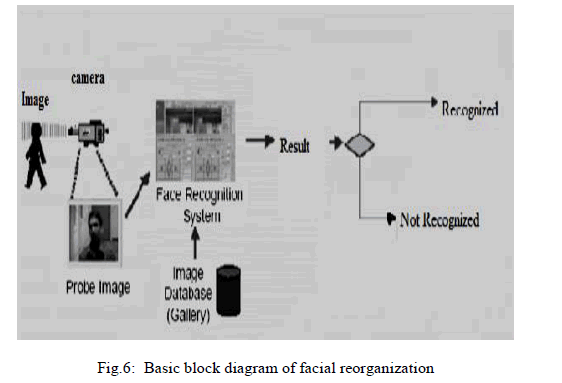 |
IV. PROPOSED METHODOLOGY |
| Face recognition is one of the best methods of automatic attendance which is accurate and time consume. In proposed methodology the input image in the system firstly we capture individual images of a person with different angles then these captured images is stored in database then we capture whole image of classroom then this image is normalized by using histogram normalization, in that image processing of contrast adjustment using image histogram. Then the noise removed from the normalize image by using median filter method. The algorithm is shown in fig.8. The faces are detected by Skin classification method and after detecting face, Eigen faces are generated which defines region of interest. These faces are compared with images stored in database. If the images from database are perfectly matched with the cropped images then the attendance of that person is marked in database and loop is repeated for each face. The block diagram is shown in fig. 7. Which represent the loop for individual person, if the image of person is matched with the images in the database then the attendance of person is marked and if not then unmarked and loop is repeated for next image. |
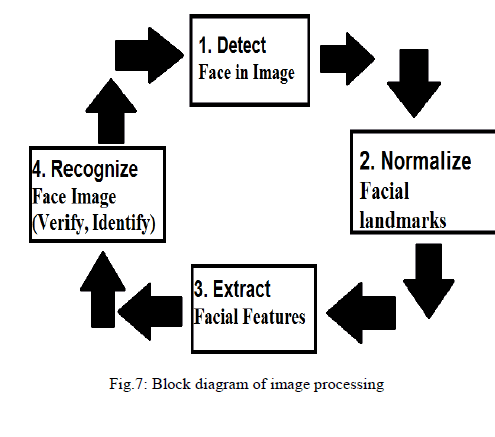 |
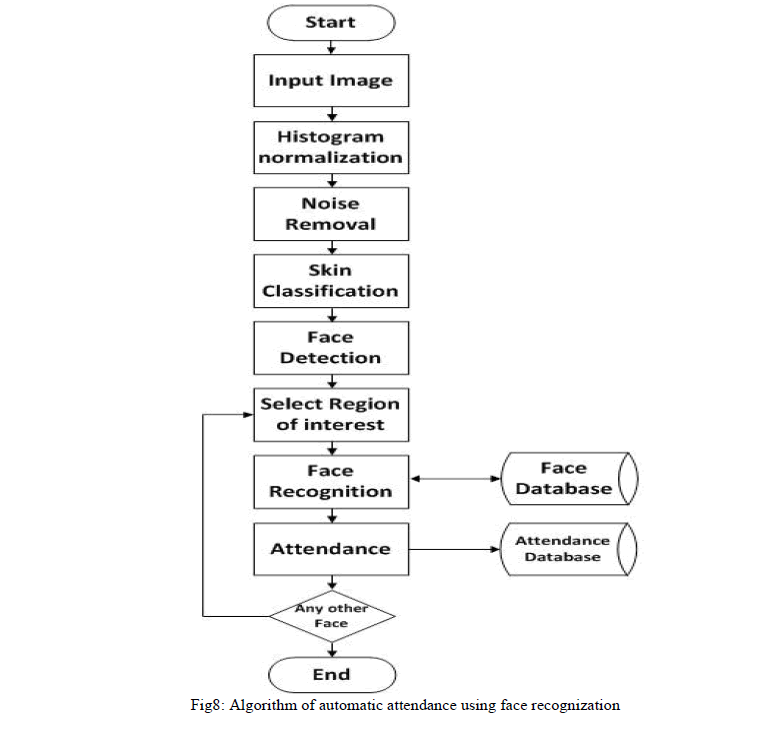 |
V. FUTURE SCOPE |
| The current recognition system has been designed for frontal views of face images. A neural network architecture (may be together with a feature based approach) can be implemented in which the orientation of the face is first determined, and then the most suitable recognition method is selected, Also the current recognition system acquires face images only from face files located on magnetic mediums. Camera and scanner support should be implemented for greater flexibility. |
VI. CONCLUSION |
| This technique described the efficient and accurate method of automatic attendance in the classroom environment that can replace the past manual methods. This novel method is secure enough, reliable and available for use. No need for specialized hardware for installing the system in the classroom. It can be constructed using a camera and computer. There is a need to use some algorithms that can recognize the faces in well to improve the system performance. This system is used for various application such as security purpose, industry, Education, Face recognition etc. |
ACKNOWLEDGMENT |
| We take this opportunity to express our deep sense of gratitude and whole hearted thanks to Guide Prof. M. K. Shriwas for his precious guidance, timely suggestions, inspiration and encouragement throughout the completion of this seminar. I want to express my deep gratitude to Prof. K. A. Dongre, Head of Electrical & Electronics Engineering Department, Prof. Ram Meghe College of Engineering & Management, Badnera-Amravati for his immense help and guidance extended to successfully complete the seminar. I am thankful to Dr. M. S. Ali, Principal, Prof. Ram Meghe College of Engineering & Management, Badnera and Amravati for providing necessary infrastructure and facilities. I am also thankful to all faculty members of Electrical & Electronics Engineering Department for their cooperation and help in this seminar work. Last but not least, I thank all those friend who helped me directly or indirectly in completing this seminar work. |
References |
|